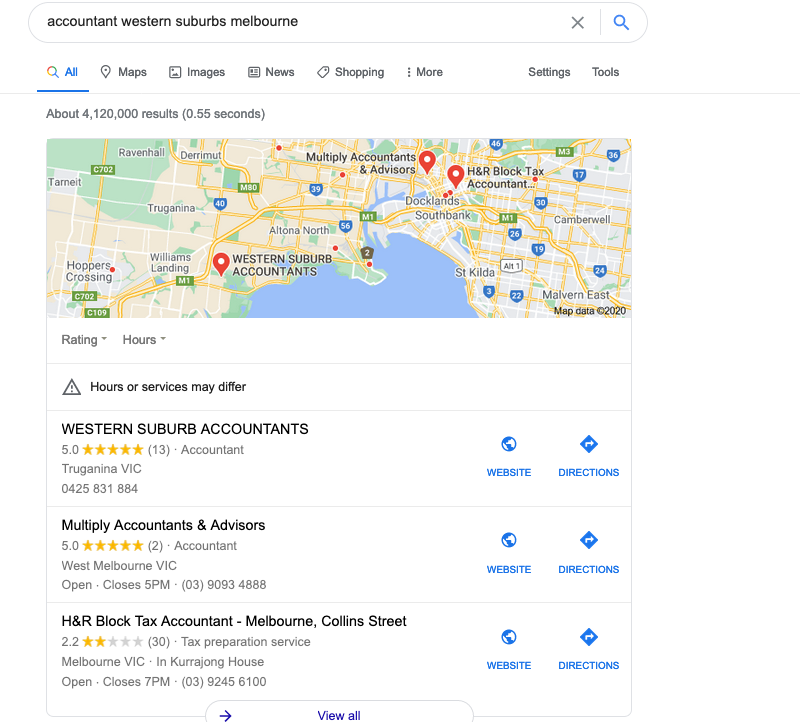If digital marketing is on your radar, you’ll know that search engine optimisation (SEO) is a valuable tool for getting noticed online and building your customer base.
In a recent Yellow Pages poll, 68% of respondents said they believe it’s important for a business to be on the first page of a Google search. The studies back this up: 75% of searchers never look past the first page of search results.
Not only that, but your position within the top 10 results also affects your click-through rate.
For example, the average click-through rate for a page in position one is 20.5%. This drops to 13.32% for position two and decreases further with each position until it reaches 7.95% at position 10.
SEO can grow your business’ visibility in search engines from the ground up and, if you already have a presence online, it helps you rise through the ranks as well.

But isn’t SEO expensive?
In a word, no.
Unlike other marketing tactics such as Search Engine Marketing (SEM), you don’t even need to spend a dollar on SEO to see results. But it will take a bit of work and patience – SEO is a slow burner and it will usually be a few months before your efforts begin to pay off.
Time considerations aside, SEO is one of the most effective digital marketing tools out there. In a survey conducted by Databox, 70% of respondents said that SEO is better than pay-per-click advertising for generating sales.
While digital marketing strategies like Google Ads can be a worthwhile investment while you ramp up your SEO efforts, focusing on SEO as a long-term strategy can lead to significant growth.
So, what’s the right SEO strategy for a small business?
Businesses of all sizes can benefit from using simple-but-effective general and local SEO tactics. As a small business owner, you probably don’t have as many resources as a big enterprise. But you can still make it work by following the principles of a well-rounded SEO strategy (and calling on help from SEO experts if you need it).
You’ll need to think about both SEO in general, and local SEO, as there is an important difference. Many businesses are already implementing SEO strategies, but not all of them are taking care to include local SEO which is vital for a small business.
What is local SEO?
Not many companies have the luxury of being able to call all geographic areas their target market. Yet, whether you’re a painter or a furniture store owner, you have your very own local audience in the nearby area. And local SEO is the way to target them specifically.
For example, if someone searches ‘plumbers near me’ (this type of search is happening a lot more now thanks to voice search), you want your plumbing business to come up at the top of the results page, where it’s the most visible.
To make this happen, you’ll need to list your address on every site possible, from your Google Business Profile to Yellow Online, and add plenty of local content and keywords that refer to your specific area.
Local SEO stats that are hard to ignore.
Just in case you need a little prodding to make some changes or invest in local SEO services, here are some incredible local SEO statistics that highlight how valuable it is:
- 46% of all Google searches are for local information (Hubspot)
- 88% of consumers who run a local search on their smartphone either call or visit a business within one day (Nectafy)
- Google saw a 900% increase in ‘X near me today/tonight’ searches in the space of just two years (Google Insights)
- 76% of people who conducted a local search on their smartphone visited a store that very same day, and more than a quarter of those made a purchase (Google data).
- Almost everyone runs local searches, with 97% of consumers searching local in 2017, and 12% of people looking every single day (Bright Local)
- 75% of people never make it past the first page of Google’s results (Hubspot)
Despite all that, 56% of stores haven’t listed their business on Google (Local Marketing Institute), and there are plenty still who aren’t listed on Yellow Pages. With a free Yellow Pages Online listing just a click away, it’s super easy to tick this one off the list.
RELATED: 7 ways to appear in more local searches.
So all in all, you really need to include both general and local search engine optimisation in your plans.
These SEO basics are a good starting point.
1. Master your keyword game.
It’s a common misconception that keywords are the be-all and end-all of SEO. Include as many keywords as possible on your website and you’ll land on page one every time, right?
In reality, to achieve success, you need to know which specific keywords to choose and use them naturally throughout your content – whether that be landing pages, blogs, directory listings or other third-party websites.
What Google really wants to see is well-written, informative content. If you force keywords in where they aren’t relevant (that’s called ‘keyword stuffing’) or you use too many keywords in close proximity, you could even be penalised by Google – which makes it very difficult to rank.
That being said, well-researched, relevant keywords are essential for contextualising your content and driving organic traffic to your website.
Fortunately, there are plenty of user-friendly tools you can use to find the right keywords. Neil Patel’s free keyword tool Ubersuggest is one of the most popular, and it works by generating keyword suggestions based on an initial keyword or domain you input:


Free SEO tools like this are a great starting point for finding the types of keywords you can use in your content to start ranking for a wider variety of relevant search terms.
Once you’ve narrowed down your list of keywords and know which ones you want to target, you can find out more about how to integrate those keywords into your content here.
2. Go where the locals go.
Not many small businesses can call every geographic area a target market. Whether you’re a hairdresser or an accountant, chances are you’ve got a specific customer base in a specific area.
Local SEO involves optimising your content specifically for those customers within your local area.
It’s easy to see why local SEO has exploded in recent years: mobile searches such as ‘accountant near me’ or ‘accountants in [suburb]’ grew by 900% over two years.
With more people using area-specific search terms, it makes sense to adapt your SEO strategy accordingly. Doing so can help attract more qualified leads i.e. people who are already looking for a business like yours in your area.
So how do you get started with local SEO?
- Get a Google Business Profile and Yellow Pages Online listing. When you have your business information listed on online directories like Google and Yellow Pages Online, search engines will show your business to customers searching for your products or services in your local area.
- Use local keywords. Instead of using general keywords such as ‘accounting firm’, use area-specific keywords like ‘accounting firm western sydney’ or ‘accounting firm parramatta’.
- Create local content. As well as using local keywords, consider creating area-specific content such as things to do in your area or news and discussion about local events. This type of content could sit on a blog, news or updates section of your website – whatever is appropriate for your business.
- Set up at least one social media profile. Aside from the value of having a social media strategy, a social media profile is another place where you can list your business name, location and contact details, all of which helps ensure your business appears when people in your area search for products or services you provide.
3. Encourage customers to leave reviews.
You probably already know positive reviews are worth their weight in gold for your small business. After all, more than two-thirds of consumers (68%) read online reviews or blogs to find out what others think about products or services, and look at an average of seven reviews before making a purchase decision.
But what you may not have realised is that reviews also impact your SEO performance.
According to Moz, customer reviews are one of the biggest factors for Google in determining a page or website’s search position. This goes for both organic text-based search results and ‘Local Pack’ results, like this example:

There are some practical things you can do to nudge customers to leave a review for your business:
Just ask! When you end a transaction with a customer, ask them to leave a review in-person or use a CRM tool to automate a follow-up email after an online sale.
List your business. Make sure your business is listed and up to date on review platforms like Google, Yellow Pages Online and other relevant sites.
Respond to existing reviews. Show prospective reviewers you listen to what your customers have to say.
Create an incentive. Offer a reward for reviews such as a 10% discount on a customer’s next purchase.
RELATED: How to get more online reviews for your business.

4. Put your content creator’s hat on.
As mentioned above, Google loves informative, helpful content – it’s really the secret sauce of SEO. So if you want to see results, you’re going to have to start creating!
Content can take the form of landing pages (pages designed to be clicked through from online ads or search results), blogs, tutorials, eBooks, white papers, infographics, videos and more. Finding out what types of content work best for your business is all about testing and learning as you go along.
Your goal shouldn’t always be to simply sell a product or service, but rather to provide something meaningful and relevant to your audience.
So if you’re a florist, this might be an in-depth guide to different types of wedding arrangements. If you’re a plumber, it could be a short video explaining what to do if your toilet is backed up. We’ve put together some more blog and content ideas for every industry here.
Remember that search engines can only ‘read’ text , so any purely visual content such as videos or infographics should be accompanied by a few hundred words or so of text on the page to give it context.
Regardless of what type of content you’re creating, aim to include one relevant keyword every couple of hundred words, as long as it makes sense in context.
RELATED: How to create standout online content for your business.
5. Get backlinks from other sites.
Backlinks (links to your site from other sites) are another major factor Google uses to determine a page’s search position. Having a strong backlink profile – links from a variety of trusted sites back to your site – can significantly impact your rankings.
In fact, big businesses value backlinks so much that many dedicate a portion of their digital marketing budget to pay for backlinks to their website. While you probably don’t have the luxury to do the same, you can contact relevant organisations to suggest reputable backlinks to your site.
For example, if your business is an Italian restaurant, you could reach out to a local media outlet about linking to your website in an article about an upcoming Italian festival. You could also build partnerships with other small businesses and offer to link to their site in exchange for them linking to yours. Just make sure these partnerships are relevant to your customer base as well.
6. Implement schema markup.
Schema markup is a powerful but under utilised type of SEO that can help boost click-throughs to your website and indirectly impact your website’s ranking in search results. One study found that pages with schema markup rank an average of four positions higher in search engine results pages than those without.
Despite the SEO benefits, less than a third of all websites use it. This equals a big opportunity to stand out from the crowd and attract new potential customers to your website.
But what is it exactly?
In a nutshell, schema markup is code you put on the HTML of a web page to provide additional detail about the content of that page. It’s useful because it helps give search engines further information about a page’s content, in turn providing users with more relevant results.
When schema markup is added to a web page, it typically creates an enhanced description (commonly known as a ‘rich snippet’) that appears in search results. There are lots of types of schema markup for articles, news, reviews, recipes, products and more.
Here’s an example of a search result for a web page marked up with review schema:

Although it involves code, you don’t have to be a web development expert to add schema markup to your website. You can find out more about implementing it in our free schema markup eBook.
How digital marketing from Yellow Pages helps your business grow online.
The team at Yellow Pages provides expert digital marketing advice and products that boost your business’ online presence. From an online listing to digital display or social media ads, we’ll tailor a digital marketing strategy designed for your business. Find out more.

